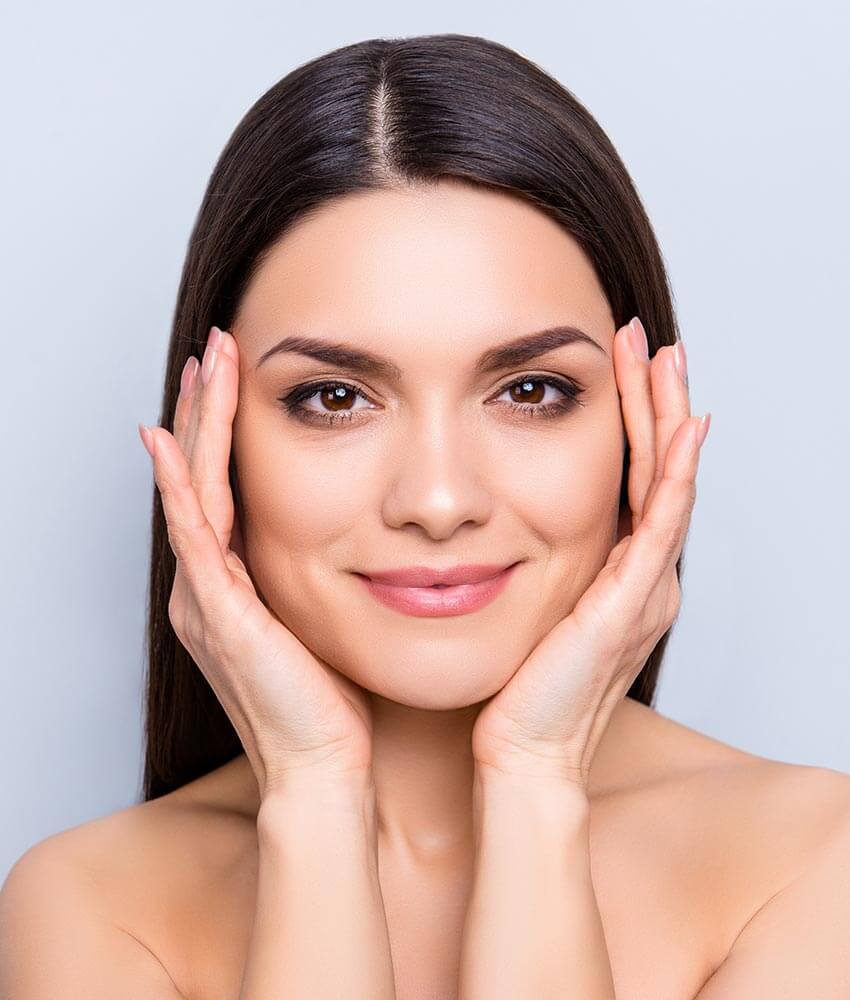When you want to look and feel your best, cosmetic procedures can help. At Clayton Eye Center, you'll find that Dr. Kang offers the most state-of-the-art techniques to help you achieve your goals. We employ surgical and non-surgical options to help our patients, no matter what.
Do you have lines or wrinkles on your face? Botox is an FDA-approved treatment to temporarily reduce the appearance of frown lines, forehead lines, and crow's feet in adults.
Botox uses a neurotoxin called botulin to help freeze wrinkles and fine lines on your face. When applied by an expert like Dr. Kang at Clayton Eye Center, results look subtle and natural and help you feel like yourself again.
Botox is also used as a form of treatment for other conditions. These may include neck spasms, hyperhidrosis, overactive bladder, lazy eye, and to help prevent chronic migraines.


Dermal fillers like Restylane and Juvederm help add volume to the face. Do your lips look thin? Are your cheeks lacking their fullness?
Fillers like Juvederm can help restore volume and fullness to the skin. Juvederm is a non-surgical option containing hyaluronic acid (HA), which naturally occurs in the body and helps deliver volume to the skin.
Another filler offered by Dr. Kang at Clayton Eye Center is Restylane. With the Restylane line of products, you can correct moderate to severe wrinkles and folds on the face. Restylane works because it's formulated to act like your body's naturally occurring hyaluronic acid, helping restore skin volume.
Blepharoplasty, also known as eyelid surgery, is often performed for cosmetic reasons. With age, it becomes more common to experience droopy or saggy eyelids.
But undergoing an upper and lower blepharoplasty can also be performed out of medical necessity. Having droopy eyelids may reduce your peripheral vision, making it much more challenging to see.
Upper and lower blepharoplasty involves undergoing eyelid surgery on your top and bottom eyelids at the same time. You can also have these procedures performed separately, or only upper or lower blepharoplasty. With upper blepharoplasty, you'll have any excess fat and skin removed that falls over the eye's natural crease.
During lower blepharoplasty, lax tissue and undereye bags are removed while improving the contour of your eyelid. The incision is placed below the lash line to remove any excess skin, and then the skin gets lifted to create a more flattering and aesthetically pleasing look.


Double eyelid surgery, also called Asian blepharoplasty, is a procedure that creates an eyelid crease. Creating the crease makes the eyelid look more symmetrical and almond-shaped.
Like with a blepharoplasty, removing fat and any excess eyelid skin may be necessary to help patients achieve the best results.
A direct brow lift is a procedure that can treat droopy eyebrows. They may impair your ability to see or make it more challenging to open your eyes. A direct brow lift may become necessary if the following occurs:
A direct brow lift involves removing skin and underlying tissue above and following the length of your eyebrows. A direct brow lift is not the same as a cosmetic brow lift.
With a cosmetic brow lift, there are no visible scars as they are discretely hidden in the hairline. During a direct brow lift, there will be a visible scar at the upper edge of the eyebrows.
It may take several months before this scar heals. Getting a direct brow lift allows patients a wider field of vision. Some patients may combine a direct brow lift with upper eyelid surgery for improved results.

Learn more about the many cosmetic and oculoplastic procedures available at Clayton Eye Center in Morrow, GA, by scheduling an appointment now!
click hereFor patients with Thyroid Eye Disease, Clayton Eye Center offers a prescription called Tepezza. With Tepezza, patients who suffer from TED can experience multi-symptom relief, including reducing eye bulging and double vision.
The medication also helps with general symptoms of Thyroid Eye Disease, including redness, swelling, and pain. Tepezza is administrated through an infusion given by your eye doctor.


Dermatochalasis is the term for excess skin, fat, or muscles in the eyelids. Although it's most seen in the upper eyelids, it can also occur in the lower lids.
Those with dermatochalasis will have bags under their eyes, which only worsens with age. Having excess skin around your eyelids is not only less than cosmetically pleasing, but it can also impact your ability to see.
Dermatochalasis can impair your vision and your quality of life. It can also be quite uncomfortable, as the excess skin may rub up against your eye and cause irritation. Dermatochalasis and ptosis may seem similar, but they are two very different conditions.
For patients with unsightly skin tags, seeing an oculoplastic surgeon like Dr. Kang is the best solution. Skin tags are small, noncancerous growths that form when your skin rubs against itself.
Most skin tags don't need treatment or removal. You can have most skin tags removed during a simple in-office procedure.
Treatment varies and may include using a sharp instrument like a scalpel to shave or cut it off, liquid nitrogen to freeze it off, or cauterization to burn it off or stop bleeding.
When the eyelids turn in or out, it can lead to irritation and difficulty seeing.
Entropion is an eye condition that occurs when your eyelid turns in toward your eye. When you have entropion, it causes your eyelashes and skin to rub up against your eye, causing irritation and discomfort to the cornea.
Entropion is more common in adults who are 60 and older.
Ectropion is an eye condition that occurs when the eyelid sags or turns out. Although it can affect both lower eyelids, it can also affect the upper eyelid.
If you have ectropion, it exposes the conjunctiva and cornea. They may become infected, dry, or irritated. The most common form of ectropion is involutional ectropion which usually occurs due to aging.
Epiblepharon is an eye condition that occurs when the eyelashes of the lower eyelid turn against the eye, causing irritation. The eyelid muscle and skin move above the eyelid margin, forming a fold of tissue that causes the lashes to point up.
Epiblepharon can involve the upper or lower eyelid, but it's most common in the lower lid. The eye condition is congenital and often seen in Asian or Hispanic children.


Eyelid retraction happens when there is an abnormal elevation of the upper eyelids and an abnormal lowering of the lower eyelids. The upper eyelids should rest right below the upper border of the cornea and iris, while the bottom eyelid rests at the lower edge of the cornea and iris.
If an eyelid retraction occurs, it makes the eyes extremely dry over time. Causes of an eyelid retraction include congenital, Graves' disease, and trauma. An eyelid retraction can be treated using oculoplastic surgery.
Ptosis is an eye condition that occurs when the upper eyelid droops or sags over the eye. Patients may experience ptosis that only slightly obscures their vision, or it may be more severe, resulting in the pupil being covered.
Those with ptosis may find that the condition limits their ability to see or may block their vision entirely. Both adults and children can suffer from ptosis.
Eyelid cancer is usually in the form of a tumor on the outer surface of the eyelid. The most common kinds of eyelid cancers treated include:
In the skin's lower epidermis, you'll find round cells called basal cells. About 80% of skin cancers come from this layer of skin and are usually due to sun exposure.
Basal cell carcinoma is the most common kind of eyelid cancer. It's usually seen on the lower eyelids in people with fair skin.
Squamous cells make up a good portion of the skin's top layer of the epidermis. About 10-30% of skin cancers are in this layer.
Squamous cell carcinoma often arises from sun exposure, but it can also appear due to burns, chemical damage, or x-ray exposure. Squamous cell carcinoma is more aggressive and spreads easily to nearby tissues.
The second most common kind of eyelid cancer is sebaceous cell carcinoma. This form of skin cancer usually occurs in those middle-aged or older.
It may begin in the meibomian glands or from the glands of Zeis, which are the sebaceous glands at the eyelashes base, although this is less common. Sebaceous cell carcinoma is an aggressive cancer that usually occurs in the upper eyelid due to radiation exposure, Muir-Torre syndrome, or Bowen's disease.
Treating sebaceous cell carcinoma may require surgical removal of the eye.
Melanoma begins in the deepest layer of the skin's epidermis. Scattered cells in this layer contain melanocytes that produce melanin. Melanoma is the most serious kind of eyelid cancer and only makes up less than 1% of all eyelid cancer cases.
Surgery is often required to treat eyelid cancers. What kind of surgery Dr. Kang performs will depend on the type of eyelid cancer you have and its severity.
Mohs reconstructive surgery is a procedure that removes skin cancer from the face and reconstructs facial features to help restore your appearance. You'll first have any cancer removed during Mohs surgery.
Mohs surgery allows for the maximum amount of preservation of healthy tissues. After removing all cancer, Dr. Kang will use proven surgical techniques to rebuild any affected facial features, like your lips, nose, or any tissue around your eyes.


Some patients suffer from facial and eyelid spasm disorders. These may cause involuntary spasms, twitching, or contraction of the facial muscles.
Blepharospasm is a rare spasm disorder that is not life-threatening. Patients may experience symptoms like involuntary spasms, blinking, or eyelid twitching.
It may start with eyelid twitching that happens occasionally and becomes more frequent. More severe cases may cause a patient to go blind as the spasms force the eyelids shut.
Another rare condition treated by Dr. Kang is a hemifacial spasm. A hemifacial spasm affects half of the face and results in the involuntary contraction of muscles in the face.
Patients may notice it begins with twitching around one eye, with spasms worsening. The eye will close and impact the shape of the mouth, affecting the quality of life. Treatment of these facial and eyelid spasms may include using Botox to help temporarily immobilize muscles from contracting.
Does your eyelid suddenly look swollen? You may have a chalazion or a hordeolum.
A chalazion occurs when a meibomian gland becomes obstructed or inflamed. If this happens, it leads to inflammation of both the gland and your eyelid.
A hordeolum (also called a stye) is an infection from the eyelash follicles or tear glands at the margin of the eyelid.
If a chalazion or a hordeolum do not respond to treatment like a warm compress, you can have them removed. Only a skilled oculoplastic surgeon like Dr. Kang can perform this procedure.
